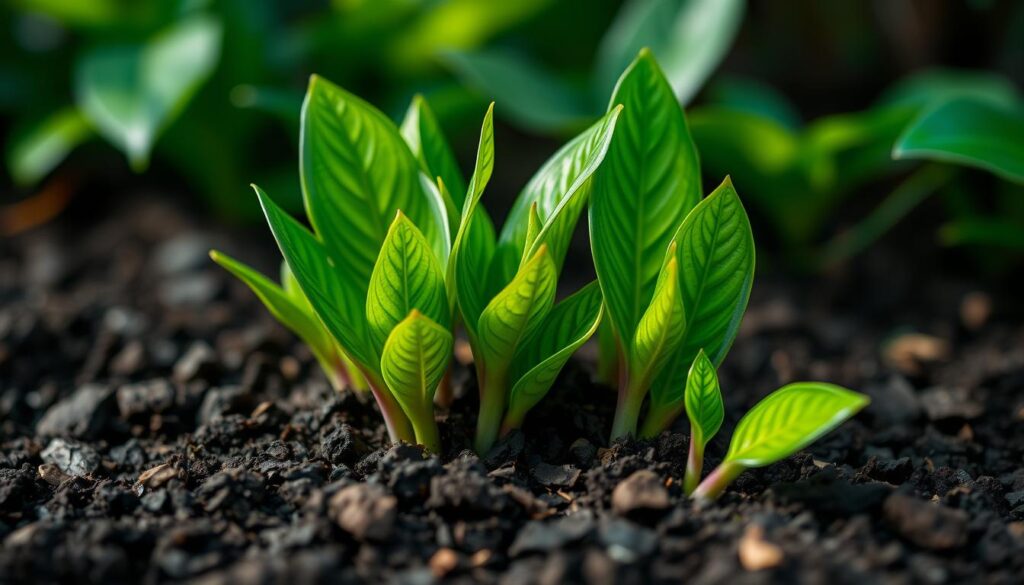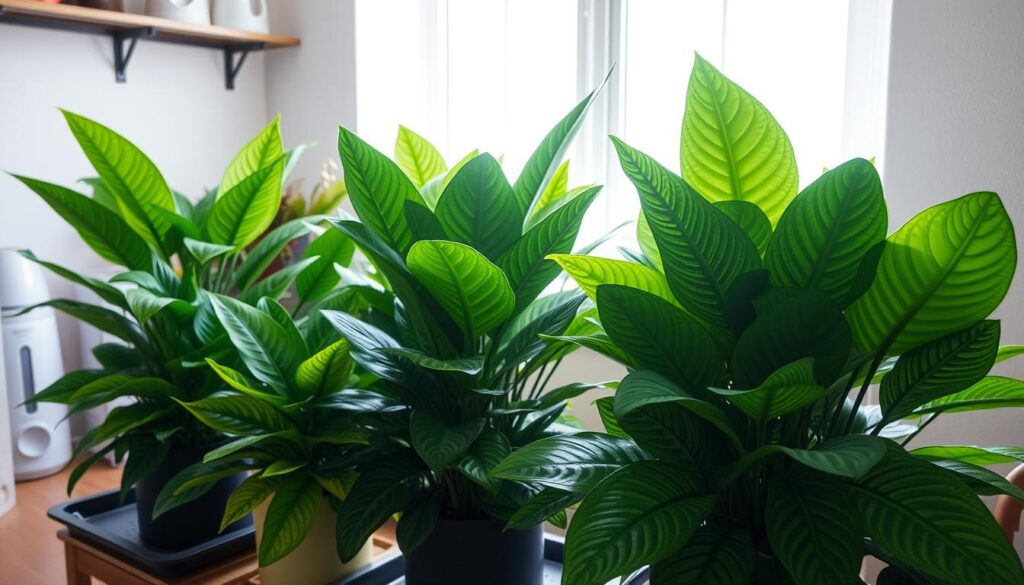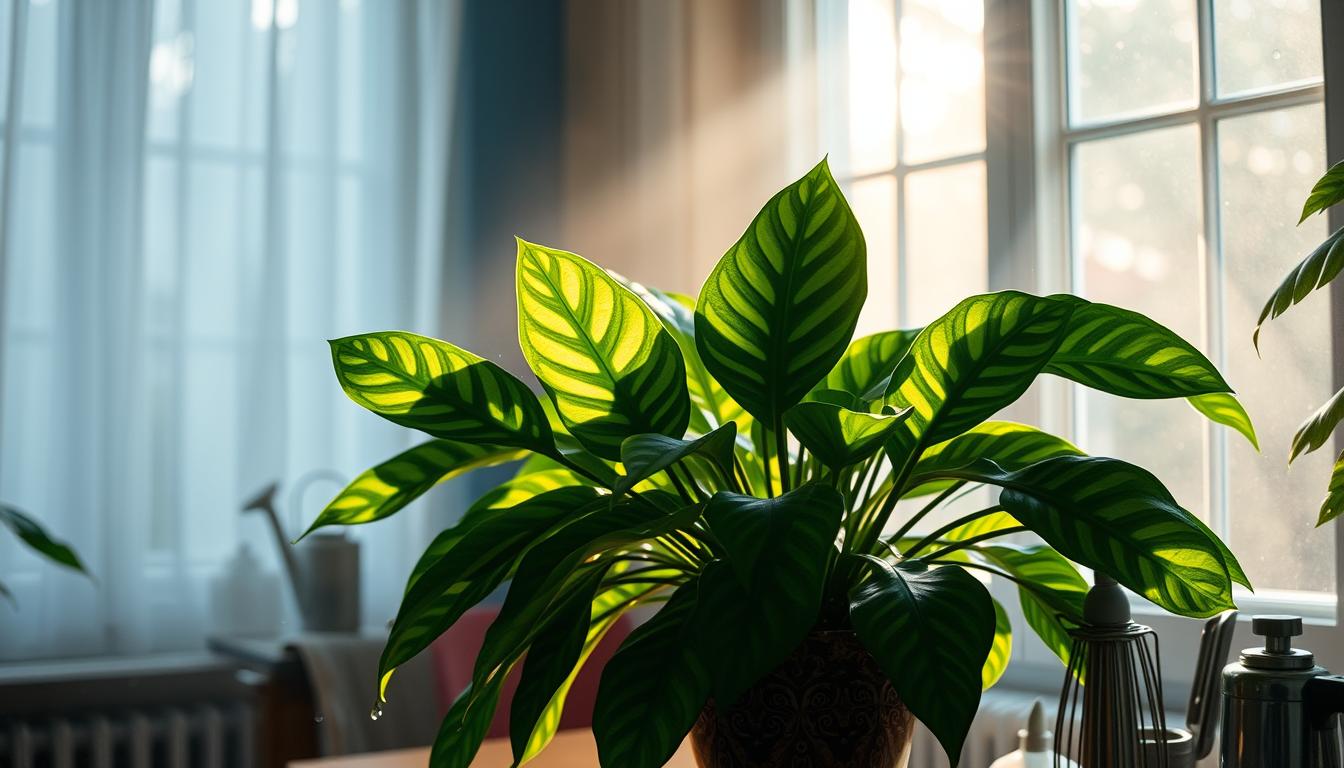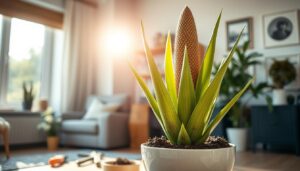Calathea plants need the right care to thrive. They are known for their beautiful leaves and clean the air. To keep your Calathea happy, you need to know what it likes.
They love bright, indirect light and warm places. They also need a lot of humidity. Follow these tips to keep your Calathea healthy and happy.
Calathea plants need special care to grow well. With the right care, they can make your home beautiful. Whether you’re new to plants or not, learning about Calathea care is important.
Knowing what your Calathea needs helps it stay healthy. It will be a beautiful part of your home.
Understanding the Calathea Plant
Exploring Calathea plants is exciting. They come from the warm, green places of Central and South America. These plants love the forest floor. Their leaves move with light and temperature changes, making them interesting for homes.
To find out more about Calathea and other great plants, check out this guide.
There are over 40 types of Calathea plants. Calathea Makoyana and Calathea Orbifolia stand out for their beautiful leaves and bright colors. Pick a Calathea that fits your home’s light and how it grows.
Knowing where Calathea plants come from helps us care for them better. They need a lot of moisture, like 50-70% humidity. By understanding their natural home, we can make a perfect spot for our Calathea to grow.
Ideal Growing Conditions for Calathea
To make your Calathea plant happy, you need to know what it likes. It loves medium to bright indirect light. But it can also handle low light. It prefers warm temperatures, between 65-75°F (18-24°C). Also, it needs high humidity, more than 50%.
Here are some key factors to consider when creating an ideal environment for your Calathea plant:
- Light: Provide medium to bright indirect light, avoiding direct sunlight.
- Temperature: Maintain a consistent temperature between 65-75°F (18-24°C).
- Humidity: Ensure high humidity levels, typically above 50%, by misting the plant regularly or using a humidifier.
By understanding and meeting these specific needs, you can create an optimal environment for your Calathea plant to thrive. Remember to monitor your plant’s response to its environment and make adjustments as necessary to ensure its health and happiness.
| Factor | Optimal Condition |
|---|---|
| Light | Medium to bright indirect light |
| Temperature | 65-75°F (18-24°C) |
| Humidity | Above 50% |
Watering Your Calathea Plant
Watering your Calathea plant is important. You should water it when the top 1-2 inches of soil feel dry. This is usually once or twice a week, depending on your home’s humidity and temperature.
Too much water can harm your plant. It can cause yellow leaves and weak stems. Not enough water can make leaves crispy and slow growth. Check the soil often and adjust your watering as needed.
Signs of Overwatering
- Yellowing leaves
- Droopy stems
- Soft and mushy roots
Signs of Underwatering
- Crispy leaves
- Slow growth
- Wilting stems
Pay attention to your plant’s water needs. Avoid too much or too little water. Water carefully and adjust as needed for a healthy plant.
Soil and Potting Needs
Choosing the right soil for your Calathea plant is key. You want a mix that drains well and is full of organic matter. This keeps the soil from getting too wet and stops root rot.
A mix of three parts potting soil to one part perlite is great. It lets water drain and air get in, helping your plant grow.
Make sure your plant’s pot is just the right size. A pot that’s too small dries out too fast. A pot that’s too big gets too wet. Pick a pot that’s only one to two sizes bigger than the old one.
Recommended Soil Types
- Well-draining potting mix
- Organic matter-rich soil
- Perlite or sand for improved drainage
Choosing the Right Pot
Think about your plant’s root size when picking a pot. A small pot dries out too fast. A big pot gets too wet. Look for pots with holes to let water drain.
| Pot Size | Recommended Soil Volume |
|---|---|
| 4-inch pot | 1-2 cups of soil |
| 6-inch pot | 2-3 cups of soil |
| 8-inch pot | 3-4 cups of soil |
Fertilizing Your Calathea
To keep your Calathea plant happy, Calathea plant fertilization is key. In spring and summer, feed it every two to four weeks. Use a balanced fertilizer like 10-10-10 or 20-20-20 for best growth.
Choosing between synthetic and organic fertilizers is up to you. Synthetic ones give a quick boost. Organic ones offer more nutrients. Always follow the package and use half the amount to protect the roots.
- Fertilize your plant during the growing season, which is spring and summer.
- Use a balanced fertilizer with a ratio of 10-10-10 or 20-20-20.
- Dilute the fertilizer to half-strength to avoid burning the roots.
- Avoid overfertilizing, as this can cause more harm than good.
Propagating Your Calathea Plant
Sharing your Calathea plant with others is fun. You need a big Calathea plant, at least 6 inches. This size helps your plant grow well.
Divide the plant’s roots to make new ones. Each new part should have lots of roots. You’ll need water for each new plant.

Keep your new plants in bright, indirect light. They like humid air, up to 60%. Change the water often to keep them healthy.
Remember, use soil that drains well and keep it warm. Don’t water too much to avoid root rot. With care, your Calathea plant will grow new shoots.
For more tips, check out trusted houseplant guides.
Here are some benefits of Calathea plant propagation:
- Encourages bushier growth
- Helps alleviate sparse plants during winter months
- Allows you to share plants with family and friends
By propagating your Calathea plant, you can enjoy these benefits. With the right care, your plant will be beautiful and vibrant.
Pest and Disease Management
To keep your Calathea plant healthy, watch out for pests and diseases. Check your plant often to spot problems early. Look for pests like mealybugs, spider mites, and scale. These can harm your plant if not treated.
Common diseases include root rot, fungal leaf spot, and bacterial leaf spot. These can come from too much water, bad air, or too much humidity. Keep your plant in the right conditions to avoid these problems.
Use neem oil and insecticidal soap to fight pests. Here are some tips for managing pests on your Calathea plant:
- Regularly inspect your plant for signs of pests or diseases
- Maintain optimal growing conditions, including temperature, humidity, and watering
- Use neem oil or insecticidal soap to control infestations
- Isolate infected plants to prevent the spread of disease
By following these tips, you can keep your Calathea plant healthy. Always watch your plant and act fast if you see pests or diseases.
| Pest/Disease | Symptoms | Treatment |
|---|---|---|
| Spider Mites | Yellowing leaves, fine webbing | Neem oil, insecticidal soap |
| Mealybugs | White, cottony patches | Insecticidal soap, neem oil |
| Root Rot | Soft, rotting roots | Improve drainage, reduce watering |
Seasonal Care for Calathea
As seasons change, so should your Calathea plant care. In winter, water and fertilize less to avoid root rot. Learn more about Calathea plant winter care to keep it healthy.
In spring, repot and fertilize your Calathea for new growth. This is key for Calathea plant spring care. Here are some seasonal care tips:
- Watering: Water your Calathea every 1-2 weeks, letting the soil dry halfway.
- Humidity: Keep humidity above 50% for best growth.
- Temperature: Keep it warm, above 15°C (59°F).

Follow these tips and adjust care with the seasons. Watch your plant and change care as needed. This will keep your Calathea happy and healthy.
| Season | Watering | Humidity | Temperature |
|---|---|---|---|
| Winter | Reduce watering | Maintain above 50% | Above 15°C (59°F) |
| Spring | Water every 1-2 weeks | Maintain above 50% | Above 15°C (59°F) |
Troubleshooting Common Issues
Keeping your Calathea plant happy can sometimes be tough. But don’t worry, you can fix common problems. This way, your Calathea will stay healthy and look great.
Leaves Browning or Curling
When your Calathea’s leaves turn brown or curl, it might mean a few things. It could be because it’s not getting enough water or because the air is too dry. Make sure to water it right and think about using a humidifier. You could also put the plant on a pebble tray to help the air around it stay moist.
Stunted Growth
If your Calathea isn’t growing fast enough, it might need more light or food. Make sure it gets bright, indirect light. Also, fertilize it when it’s growing. If the plant is too big for its pot, it’s time to get a bigger one.
By fixing these common problems, your Calathea will do well. It will add beauty to your home. With care and patience, your Calathea will be a beautiful part of your plant collection.




